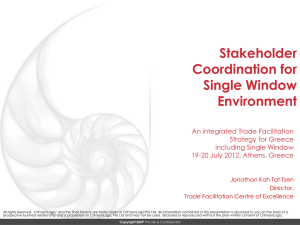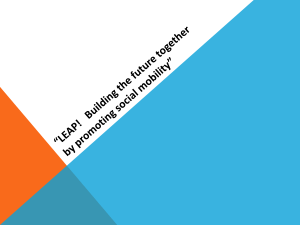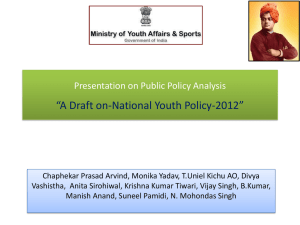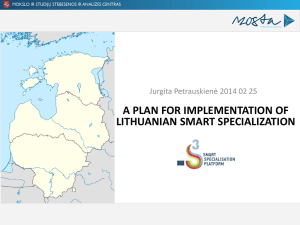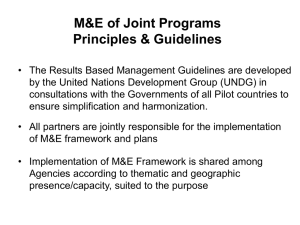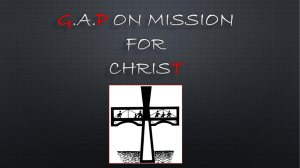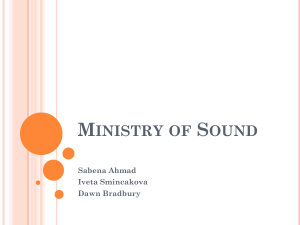Session 4 – Institutionalizing Stakeholder Coordination
advertisement
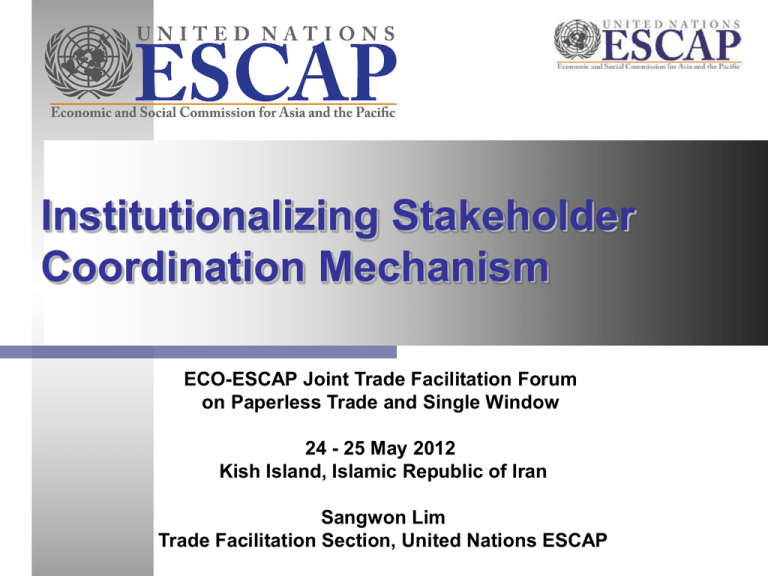
Institutionalizing Stakeholder Coordination Mechanism ECO-ESCAP Joint Trade Facilitation Forum on Paperless Trade and Single Window 24 - 25 May 2012 Kish Island, Islamic Republic of Iran Sangwon Lim Trade Facilitation Section, United Nations ESCAP 1. To-do’s in Stakeholder Coordination Set Clear Scope Facilitate Inter-Agency Coordination Keep Stakeholders Engaged lder o h n ke Sta dinatio r Coo for w in d o W le nt Sing ironme Env Appoint Strong Lead Agency Build Proper Communication Channel Ensure Political Commitment with Strategic Mandate 1-1. Political Commitment and Strategic Mandate Political commitment and strategic mandate can facilitate initiation of SW implementation and its sustainability Additional Implications for successful implementation Direct bearing on mobilizing resources. Effective engagement of stakeholders in SW implementation Legal framework for Single Window implementation and operation Cases Singapore’s TradeNet ASEAN Single Window 1-2. Strong Lead Agency (Pertinent Features) Political and/or legal empowerment for the implementation of the Single Window Strong self-commitment of the organization as a whole A committed leader within the organization to spearhead the process Mandated authority over trade-related regulatory requirements Adequate human and financial resources to carry out the implementation Technical and managerial capacity to handle diverse implementation issues Connectivity with other stakeholders, including the trading community 1-2. Strong Lead Agency (Cont’d) Cases: Lead Agencies of Single Window and Paperless Trade Projects Country Lead Agency Institutional Mechanism Thailand Thailand Customs Department NCTLD Vietnam General Department of Vietnam Customs National Steering Committee Indonesia Indonesia Customs INSW Preparation Team Malaysia Ministry of International Trade and Industry (MITI) National Single Window Committee Singapore Korea (Rep.) Kenya International Enterprise Singapore Ministry of Knowledge Economy e-Trade Facilitation Center Kenya Revenue Authority (KRA) and Kenya Ports NSWS Steering Authority (KPA), Committee * Customs to play a key role 1-3. Keep Stakeholders Engaged Formal institutional arrangements should be put in place to facilitate the participation of all stakeholders in the development of SW--relevant government agencies and private sector representatives. UN/CEFACT Rec. 4 - National Trade Facilitation Committee “Facilitation activities must be approached in a coordinated manner to ensure that problems are not created in one part of the transaction chain by introducing solutions to another part. The needs of all parties, both private and public sectors, must be identified before solutions can be found and those best placed to explain their needs are those directly involved in the transaction chain. This requires an effective forum where private sector managers, publicsector administrators and policy makers can work together towards the effective implementation of jointly-agreed facilitation measures.” 1-3. Keep Stakeholders Engaged (Cont’d) Cabinet National Committee on Thailand Logistics Development (NCTLD) Public Sector MOL Private sector MOAC Logistics JCP MOT Thai National Shipper Council MOHE NESDB MOE JCP NESDB MOC MOF MOICT MOI Academics • Regulators • Service provider • Supporter and Policy maker Thai Researchers Consortium of Value Chain Management and Logistics Industry Associations Academics from Universities Experts and Practitioners Logistics Associations • Manufacturer • Exporters • LSPs MOL: Ministry of Labour, MOAC: Ministry of Agriculture and Cooperatives, MOHE: Ministry of Higher Education, MOI: Ministry of Industry, MOICT: Ministry of Information Communication Technology, MOF: Ministry of Finance MOC: Ministry of Commerce, MOE: Ministry of Education, JCP: Joint Committee of Private Sector, LSP: Logistics Service Provider, MOT: Ministry of Transport Source: Suriyon Thunkijianukij, “Mechanisms for an Effective Inter-agency Coordination and Collaboration”, paper presented at the ESCAP/UNECE National Workshop on Establishing a Single Window in Mongolia, Ulaanbaatar, 29 Sep. – 1 Oct. 2009. 1-4. Facilitate Inter-agency Coordination Possible perception of government agencies on SW implementation as a potential threat to their authority over relevant regulatory processes in international trade. Legal mandate and high-level political commitment would help. Institutional arrangement for inter-agency collaboration is crucial, especially in dealing with issues of change management. Establishing a neutral platform for open dialogue at the very beginning of SW design, in such form as a national committee, can help. Make stakeholders understand that SW implementation does not necessarily mean the integration of all the trade-related regulatory services into one big system. 1-5. Set Clear Scope Clearly define the scope of Single Window implementation at the outset, to avoid different interpretation and expectation among the stakeholders. Set the scope with as wide as possible participation of stakeholders. Having clear implementation scope is critical in developing feasible master plan with specific implementation details. UNCEFACT Recommendation No. 33 “Setting the scope is to “be based on a careful analysis of the needs, aspirations and resources of the key stakeholders, and also on the existing infrastructure and current approaches to the submission of trade-related information to government” 1-6. Build Proper Communication Channel Communication channel is needed throughout implementation process, to prevent misunderstanding and promote ownership. Trust and understanding built over consistent communication facilitate adoption and use by the stakeholders in the operation stage of the SW . Proper communication channel with regular update of implementation progress help stakeholders to prepare themselves for change management . Establishing a neutral platform for open dialogue at the very beginning of SW design, in such form as a national committee, can help. Examples of Communication Channels Used Regular meetings, briefing sessions, public seminars and conferences, mass Media, electronic means (website, newsletter, group mail, etc.) 2. Implementation Case: Republic of Korea National e-Trade Committee Private e-Trade Committee Chair : Prime Minister Chair : Dr. Jung Uck, Seo Administrative Committee Chair : Vice Minister of MOCIE Korea e-Trade Facilitation Center Platform W/G e-TP PM e-TDR Law W/G Law Reform Finance W/G e-L/C e-Nego Logistics W/G RFID e-L/G e-D/O Marketing W/G e-MP e-Catalog Solutions Global W/G e-C/O e-B/L APEC,ASEM Bilateral Networking Dr. Jung Uck, Seo: Former Minister of Science & Technology and Chairman of Korea e-Business Association MOCIE: Ministry of Commerce, Industry and Energy, KITA: Korea International Trade Association KFTC: Korea Financial Telecommunications and Clearings Institute, W/G: Working Group, e-TP PM: e-Trade Portal Project management, e-TDR: e-Trade Document Repository, e-L/C: e-Letter of Credit, e-Nego: e-Negotiation, e-L/G: e-Letter of Guarantee, e-D/O: e-Delivery Order, e-MP: e-Market Place e-C/O: e-Certificate of Origin, e-B/L: e-Bill of Lading Thank you www.unescap.org/tid www.unescap.org/unnext

